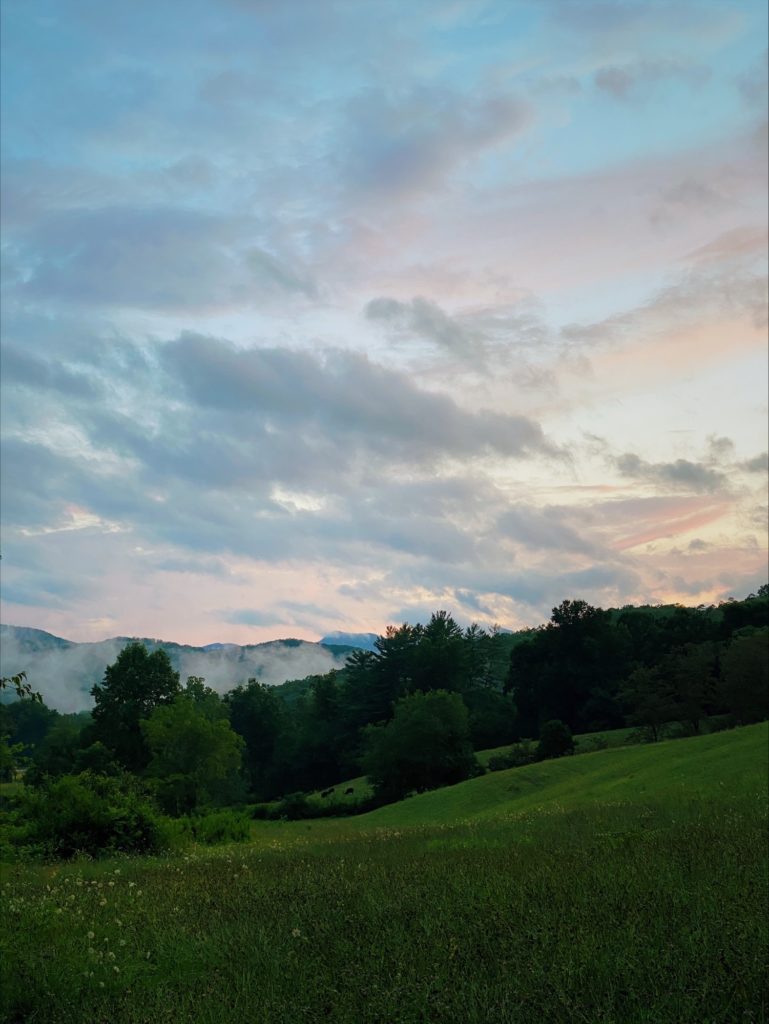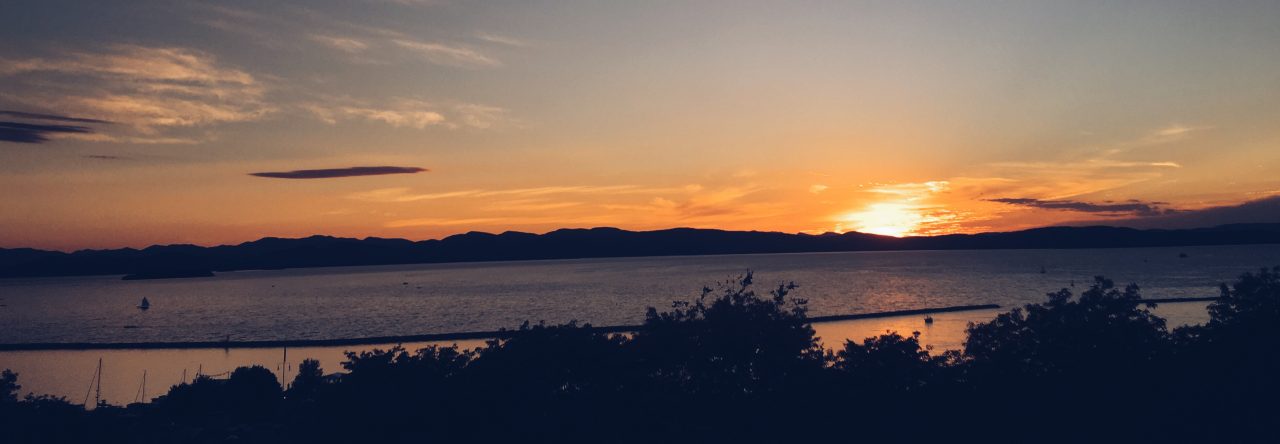
Scenes from our first mountain summer.
We walk in the evenings, for even in the mountains the days get warm. Once the sun falls past the ridge line, the valley releases into the cool of evening. A simple walk: up the road that leads to our house, up toward the meadow, where the valley floor accommodates a sloped pasture, where on the upper side grows hay, and on the far side the cattle graze.
Golden hour in the Appalachians sets the vista in theatrical light. The tops of the ridges bask in glow; straight down the valley, the broad shoulders of other ridges, still warm, fade into a deep green, then into orange, and then into shadow.
It is certainly warm enough to work up a sweat, but in the evening the settling temperatures tend to stir up a breeze more often than not, and this dappled wind is grace. You can hear it pour down from up the hill, rustling the leaves in a way that tricks your ears at first–is it a car? Is it a sudden rush of water?–before it greets your face. Out here, you can hear the breeze coming just like you can hear any cars long before they appear. Not much else makes much noise.
The dwellings that dot the road here and there add up to a neighborhood of sorts, stretched out over a couple miles. There is a white, clapboard house where an older lady lives. Like many mountain folks, she keeps her windows open in the summer, and in the evenings I can see the top of her head above the half curtain in the kitchen window. She sings hymns while she washes the dishes, the clattering about the sink a disjointed percussion accompaniment, the sound carrying straight down to the road.
A dignified singlewide, complete with a comfortable covered porch and thriving garden out back and a pair of yipping terriers, irregularly hosts a group of bluegrass musicians. A banjo carries further than even I thought it would.
It is a wet summer, the kind where some continental pattern of wind and moisture conspires to deliver us a good rain shower most afternoons and some evenings. On a handful of occasions, I’ve struck out on my walk without knowing that pregnant, dark clouds lurked on the other side of the mountain, out of sight. They find me on the way up or back, the rush of breeze followed by the patter of rain drumming on an omnipresent canopy of leaves, the ozone scent of cool rainwater seeping into the warm asphalt road. The cows hunker down under a proud maple, and later, the woods exhale whispers of vapor that adorn the crown of the ridge like ethereal veils.
All of the rain seeps into the tops of the mountains and leaks out below. I did not understand this at all until we moved here, how water tables work in the elevations, how springs simply form here and there, bubbling up under rocks or tree roots, channeling together as they whisk down the hill to join Locust Creek.
A handful of houses have these little springs running straight through the yard, cutting along or across. One house, the one with deep, pentatonic windchimes hanging from its porch, has tried to contain and direct the water running through, burying it and draining it through a pipe that empties by the roadside. Over the summer, when the weather pattern dries, I see the little spring run thinner and thinner. The creek stays full, though, bustling out of our cove toward the Tuckaseegee.
The Fourth of July weekend we wander into town to visit with new friends. A couple we’ve met run the rafting company in Dillsboro, and they invite us to their riverside place at the end of the day, after all the paying customers have left. Adam sets to work grilling a simple supper. The college kids who work summers here mill about, hanging up life vests to dry, arranging equipment for the evening. The resident pup, whose name I can never remember and always greet as just hey, River Dog! wanders around with the children.
After supper, we pack a few drinks and shove off in a small flotilla of kayaks, rafts, and a canoe. A mile down the river, the sunset glow lighting the mountains, River Dog perched on the bow of a canoe, there is nothing but happiness and cheer.
As days run into weeks, the work of summer progresses on Locust Creek in the tempo of the heat: cutting hay, letting it dry, bailing it. A husband and wife gather a curious collection of boards and planks and begin to fashion what begins as a comically small shed but soon emerges as a chicken coop. By August, there are a dozen egg layers at work pecking about the soil. The couple paints the shed white, working in the cool evening shade bit by bit, waving as we walk past.
An old man near us has planted a single row of grape vines down near the creek, though I never see him tending them other than to mow the grass around the trusses short. At nights, he watches Jeopardy! from the living room at the front of his house.
There are a lot of older people who live along Locust Creek, and there are traces of homesteads much, much older, chimneys that stand alone like guardians deep in the forest. I think of babies born in the cabins that embraced those hollow stone columns, of a time when walking from cabin to cabin was about all one could do, of a time when calling on one’s neighbors was the social media, how even alone in this valley, we were together.
Life springs up from the ditches–wildflowers of every color and name, sassafras, blackberries, milkweed, poison ivy–and flourishes. The woods can grow jungle-thick here in the lower reaches. Somewhere there is a colony of honey bees; in the fading light I see them flying in straight lines from one point in the trees to another out in the field, back and forth, gathering pollen until it is too dark to worry any longer, the sweet smells of the forest carried on a friendly breeze, the music floating over from a front porch or kitchen sink, the careful stage rightly set for night.






Leave a Reply